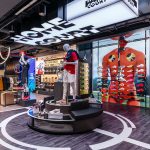Kathmandu Holdings Limited, which operates 114 outdoor specialty stores in Australia, New Zealand and the United Kingdom, reported its earnings before interest and taxes (EBIT) fell 36.2 percent to NZ$12.7 million ($10mm), for the half-year ended Jan. 31 compared to the same period a year earlier as it had to discount heavily to move merchandize. Net profit after tax (NPAT) decreased from NZ$10.5 million to NZ$6.0 million for the same period.
The company said sales rose 15.4 percent to NZ$146.7 million ($117mm), while gross profit rose 11.9 percent to NZ$92, or 62.7 percent of sales, down 200 basis points from a year earlier but still within the company’s target range. Margins were reduced in all three countries due primarily to the proportionally greater volume of sales made at lower margin due to higher discounting and greater clearance activity.
Sales rose 18.1 percent to NZ$88.3 million ($70mm) in Australia, 13.7 percent to NZ$54.7 million ($44mm) in New Zealand, but declined 13.6 percent to $NZ3.7 million ($3mm) in the United Kingdom.
“Sales over the period were very strong; however this was achieved at lower gross margins and incurred higher costs,” said CEO Peter Halkett. “Following slow Christmas trading, more aggressive promotional and marketing activity was undertaken during January to maximize profits and rate of inventory sell-through. Additionally net profit was impacted by one off costs associated with our core system upgrade and our brand refresh project.”
In the first half year of FY12 same store sales growth was 8.0% (7.8% at comparable exchange rates). That broke down to 6.4 percent in Australia, 12.7 percent in New Zealand and a decline of 13.6 percent in the United Kingdom. Online sales growth of 50 percent helped prop up same-store sales growth.
Kathmandu's operating expenses increased by 470 bps as a % of sales. An increased advertising spend, higher occupancy costs, and an increase in distribution costs were the major contributors to this % change. Retail salaries and wages increases in Australia also exceeded the rate of sales increase, which reflects the continuing labour cost pressures in that market.
Included within the overall operating expense increase were one-off costs of approximately $2 million associated with the core system upgrade and brand refresh. For the full year, operating costs as a % of sales are expected to be higher than the result achieved in FY11, but not to the same level as experienced in the first half-year.
“Active management of the level of operating costs will be a key focus in the second half, and the investment made in systems and infrastructure will gain further efficiency improvement in the future” said Mr Halkett.
EBITDA margin for the first half year decreased from 18.3% to 11.6% and EBIT margin decreased from 15.7% to 8.7%.
Total inventories increased by 38.4%, or NZ$21.3 million and by 21.4% on a $per store basis. This was mainly as a result of the planned investment in product range growth, slightly fewer new stores being open than anticipated and higher levels of goods in transit. Total net debt at 31 January increased by 10.5% on the previous year as a result of funding required for the investment in inventory and the capital expenditure programme. The ratio of net debt to net debt plus equity has remained similar at approximately 25%.
The company opened 5 new stores and now has 68 open in Australia, 40 in New Zealand and 6 in the United Kingdom. Sales made to Summit Club members, the company's customer loyalty program, rose at a faster rate than the overall rate of increase in sales.
“Our target and expectation is to have one million active Summit Club members across New Zealand and Australia within two years,” Halkett said.
Kathmandu now expects to open between 11 and 15 new permanent stores in the full financial year. The following new Australian permanent store locations are expected to be open prior to 31 July 2012: Tamworth (NSW), Moorabbin DFO (Melbourne), Shellharbour (NSW) and The Rocks (Sydney). Two or three other sites are currently under negotiation.
No new stores are planned for the UK at this time. Future sales growth will be via increased activity supporting our enhanced UK internet site, due for launch early next financial year. Peter Halkett said “we have also taken steps to reduce our UK cost base by outsourcing warehousing and distribution to a third party service provider. Other initiatives are underway to further reduce the current cost structure.”














